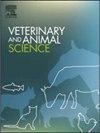Infrared thermographic imaging as a promising on-farm method to estimate parasite load in dairy goats
IF 1.9
Q2 AGRICULTURE, DAIRY & ANIMAL SCIENCE
引用次数: 0
Abstract
Faecal egg count (FEC) evaluation is the method of choice to detect parasite load in individuals, but it cannot be used directly on farm. Clinical parameters like body condition scores (BCS), body weight (BW) and milk yield (MY) have been described in this context, but all fail due to a low correlation with FEC. The present study evaluated the utility of clinical parameters, linear body measurements, and infrared thermographic imaging (IRT) in eight dairy goat herds in Germany as potential methods for estimating FEC categories. A total of 893 dairy goats comprising German Fawn Goats (GFG) and German White Goats (GWG) were examined up to six times during three consecutive lactation periods. FEC was determined using individual faecal samples, analysed via the McMaster method. Based on eggs per gram of faeces (EPG), mean FEC across all examinations was categorized into three groups: low (Category 1: ≤500 EPG), medium (Category 2: >500 to ≤1500 EPG), and high (Category 3: >1500 EPG). Statistical analyses were conducted using SAS Studio to identify factors influencing FEC. Significant differences were observed between the two breeds.
In GFG, animals in Category 3 exhibited significantly lower BCS, BW, chest circumference, and MY compared to those in Category 1. IRT measurements also showed significant differences across FEC categories, with higher IRT values observed in goats with higher FEC. These findings suggest that IRT has potential as a non-invasive, on-farm method for assessing parasitic load. However, further studies are necessary to validate its practical application as a direct health monitoring method.
红外热成像作为一种很有前途的农场方法来估计奶山羊的寄生虫负荷
粪卵计数(FEC)评估是检测个体寄生虫负荷的首选方法,但不能直接在农场使用。临床参数,如身体状况评分(BCS),体重(BW)和产奶量(MY)已经在这方面进行了描述,但由于与FEC的相关性较低,这些参数都失败了。本研究评估了临床参数、线性身体测量和红外热成像(IRT)在德国8个奶山羊群中的效用,作为估计FEC类别的潜在方法。共有893只奶山羊,包括德国小鹿山羊(GFG)和德国白山羊(GWG),在连续三个哺乳期进行了多达6次的检查。利用个体粪便样本测定FEC,并通过麦克马斯特方法进行分析。根据每克粪便的卵数(EPG),所有检查的平均FEC分为三组:低(第一类:≤500 EPG),中(第二类:>;500至≤1500 EPG)和高(第三类:>;1500 EPG)。采用SAS Studio进行统计分析,确定影响FEC的因素。两个品种之间存在显著差异。在GFG中,与第1类动物相比,第3类动物的BCS、体重、胸围和MY明显较低。IRT测量也显示出FEC类别之间的显著差异,在FEC较高的山羊中观察到较高的IRT值。这些发现表明,IRT有潜力作为一种非侵入性的农场寄生负荷评估方法。然而,需要进一步的研究来验证其作为直接健康监测方法的实际应用。
本文章由计算机程序翻译,如有差异,请以英文原文为准。
求助全文
约1分钟内获得全文
求助全文
来源期刊

Veterinary and Animal Science
Veterinary-Veterinary (all)
CiteScore
3.50
自引率
0.00%
发文量
43
审稿时长
47 days
 求助内容:
求助内容: 应助结果提醒方式:
应助结果提醒方式:


